Annual Demographic Estimates: Canada, Provinces and Territories, 2018 (Total Population only)
Analysis: Total Population
Archived Content
Information identified as archived is provided for reference, research or recordkeeping purposes. It is not subject to the Government of Canada Web Standards and has not been altered or updated since it was archived. Please "contact us" to request a format other than those available.
Skip to text
Text begins
For the first time, the estimates in this publication are based on the 2016 Census counts adjusted for census net undercoverage and incompletely enumerated Indian reserves, to which is added the estimated population growth for the period from May 10, 2016 to the date of the estimate. The data starting from July 2001 were also revised.
The analysis in this publication is based on preliminary data. These data will be revised over the coming years, and it is possible that some trends described in this publication will change as a result of these revisions. Therefore, this publication should be interpreted with caution.
This section presents the population estimates for Canada, the provinces and the territories on July 1, 2018, along with a concise analysis of the various components of population growth for 2017/2018. These estimates now being based on the 2016 Census, the section ends with a brief analysis of the impact of the base change and the intercensal increases observed in recent cycles (see the box “Rebasing (2016)”).
The population of Canada continues to grow at a steady pace
On July 1, 2018, Canada’s population was estimated at 37,058,856, up 518,588 from July 1, 2017. The country’s population growth rate was 1.4%,Note 1 a level not seen since 1989/1990 (1.5%). In absolute numbers, Canada’s population growth in the past year (+518,588) reached a high not seen since 1956/1957, a period when the annual number of births was among the highest ever, the country being at the height of the baby boom, and at a time when many Hungarian refugeesNote 2 arrived in the country.
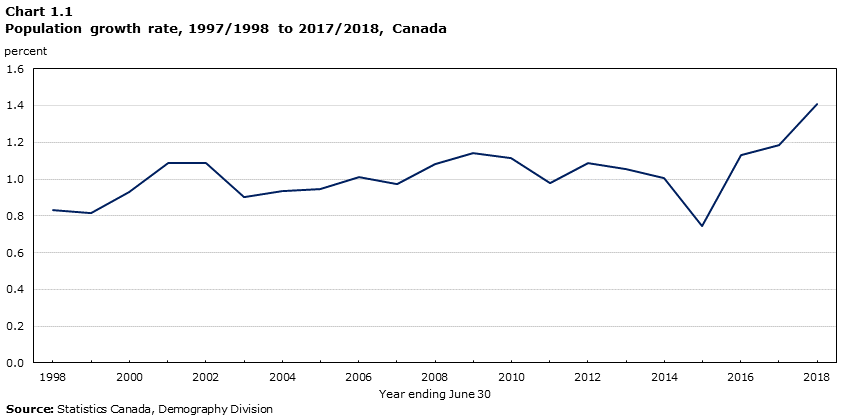
Data table for Chart 1.1
| Year ending June 30 | percent |
|---|---|
| 1998 | 0.83 |
| 1999 | 0.81 |
| 2000 | 0.93 |
| 2001 | 1.09 |
| 2002 | 1.09 |
| 2003 | 0.90 |
| 2004 | 0.93 |
| 2005 | 0.94 |
| 2006 | 1.01 |
| 2007 | 0.97 |
| 2008 | 1.08 |
| 2009 | 1.14 |
| 2010 | 1.11 |
| 2011 | 0.98 |
| 2012 | 1.09 |
| 2013 | 1.06 |
| 2014 | 1.01 |
| 2015 | 0.75 |
| 2016 | 1.13 |
| 2017 | 1.19 |
| 2018 | 1.41 |
| Source: Statistics Canada, Demography Division | |
Canada posts the strongest population growth of the G7 countries
During the past year, the country’s population growth remained the highest among all G7 countries. Canada’s population growth rate was twice that of the second-place country, the United States (+0.7%). Canada’s population growth rate was also two to four times higher than the rates of all the other G7 countries that posted an increase: the United Kingdom (+0.6%), France and Germany (+0.3% each). Lastly, it contrasts with the population decreases observed in Italy and Japan (‑0.2% each).
However, Canada’s population growth was not the highest among industrialized countries; it was slightly lower than the increases observed in Australia (+1.6%) and New Zealand (+1.9%), for example.Note 3

Data table for Chart 1.2
| CountryData table Note 1 | rate (%) |
|---|---|
| Japan | -0.2 |
| Italy | -0.2 |
| Germany | 0.3 |
| France | 0.3 |
| United Kingdom | 0.6 |
| United States | 0.7 |
| Canada | 1.4 |
|
|
International migration accounts for most of the population growth
Population growth at the national level is based on two factors: natural increaseNote 4 and international migratory increase,Note 5 while provincial and territorial population estimates also factor in interprovincial migration.
Between July 1, 2017, and July 1, 2018, international migratory increase was 412,747, the highest level ever recorded, widely surpassing (by over 90,000 individuals) the peak of 320,750 recorded last year.
Since 1995/1996, international migration has consistently been the main driver of population growth in Canada. In the past year, more than three-quarters of the population growth stemmed from international migratory increase (79.6%), a never-before-seen level. By comparison, international migratory increase accounted for, on average less than half (44.3%) of the population growth in the early 1990s.
In the past year, natural increase totalled 105,841 persons, the lowest level recorded in Canada,Note 6 on account of the growing number of deaths due essentially to population aging. Specifically, natural increase in 2017/2018 was the difference between 385,777 births and 279,936 deaths based on preliminary estimates.

Data table for Chart 1.3
| Year ending June 30 | Natural increase | Net international migration | Population growth |
|---|---|---|---|
| number | |||
| 1998 | 127,435 | 131,768 | 249,225 |
| 1999 | 120,663 | 135,427 | 246,113 |
| 2000 | 119,683 | 174,769 | 284,444 |
| 2001 | 107,993 | 236,700 | 335,172 |
| 2002 | 107,661 | 237,935 | 339,177 |
| 2003 | 106,618 | 183,749 | 283,949 |
| 2004 | 108,933 | 194,128 | 296,627 |
| 2005 | 109,364 | 200,154 | 303,098 |
| 2006 | 120,593 | 216,093 | 327,421 |
| 2007 | 127,091 | 219,749 | 317,851 |
| 2008 | 137,170 | 249,993 | 358,093 |
| 2009 | 141,582 | 269,184 | 381,777 |
| 2010 | 142,235 | 262,750 | 375,994 |
| 2011 | 131,456 | 230,981 | 334,439 |
| 2012 | 136,430 | 260,564 | 374,894 |
| 2013 | 129,951 | 260,820 | 368,732 |
| 2014 | 129,229 | 247,290 | 354,481 |
| 2015 | 117,154 | 170,354 | 265,473 |
| 2016 | 121,492 | 304,047 | 406,579 |
| 2017 | 110,031 | 320,750 | 430,781 |
| 2018 | 105,841 | 412,747 | 518,588 |
| Note: Until 2016 inclusively, population growth is not equal to the sum of natural increase and international migratory increase because residual deviation must also be considered in the calculation. Source: Statistics Canada, Demography Division. |
|||
International migratory increase peaks in several provinces and territories
Since the beginning of the period covered by the current demographic accounting system (July 1971), never-before-seen levels of international migratory increase were observed in Nova Scotia (+7,419), Quebec (+82,943), Ontario (+192,679), British Columbia (+55,457) and Yukon (+429). International migration was also high in the other provinces.
Last year’s unprecedented level of international migration is the result of strong immigration levels and the arrival of a significant number of non‑permanent residents. Canada welcomed 303,257 immigrants last year, the second-highest number observed during the study period from 1971 to 2018.Note 7 The highest number was recorded in 2015/2016 (323,192 immigrants), when Canada welcomed many Syrian refugees.
Meanwhile, the number of non‑permanent residents increased by 165,729 during the past year, compared with a gain of 103,597 in 2016/2017. This is the highest increase during the study period from 1971 to 2018, exceeding the peak of 140,748 non‑permanent residents in 1988/1989, when the Immigration and Refugee Board of Canada was created and a new refugee determination system introduced. Last year was marked by a considerable increase (46.7%) in the number of refugee claimants, compared with a 14.3% increase in work permit holders and an 18.6% rise in study permit holders. However, individuals who claimed refugee status represented 21.3% of the increase in the number of non‑permanent residents in 2017/2018, as opposed to 40.0% for work permit holders and 39.0% for study permit holdersNote 8.
Various factors can affect international migration variations and trends. For example, Immigration, Refugees and Citizenship Canada (IRCC) is regularly called on to revise the brackets for immigration levels, in keeping with the framework set out in the Immigration and Refugee Protection Act.Note 9 The recent rise in the number of immigrants is consistent with the levels established by the IRCC.Note 10 In addition, the number of non‑permanent residents can fluctuate based on the economic and political climate in Canada and elsewhere in the world. There are three main categories of non‑permanent residents: work permit holders, study permit holders, and refugee claimants. The number of work and study permit holders can rise or fall based on the economic context of the country of origin and the host country, as on the directions of certain programs in Canada and in the provinces and territories. Meanwhile, the number of refugee claimants can vary based on the political context in their country of origin and on decisions made in Canada. Emigration trends are more closely linked to both the internal and external economic situation.
More than four out of five Canadians live in four provinces
On July 1, 2018, more than 32 million Canadians (86.4%) were living in one of four provinces: Ontario (38.6%), Quebec (22.6%), British Columbia (13.5%) or Alberta (11.6%). Ontario remains the country’s most populated province, with 14,322,757 inhabitants. Quebec is the second most populous province (8,390,499), followed by British Columbia (4,991,687) and Alberta (4,307,110).
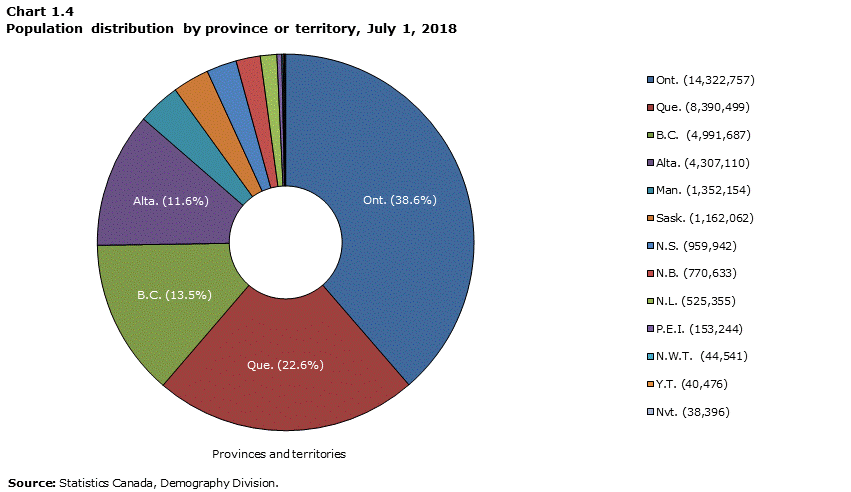
Description for Chart 1.4
The pie chart has the following 13 sections:
| Provinces and territories | Proportion |
|---|---|
| Ont. | 38.6% |
| Que. | 22.6% |
| B.C. | 13.5% |
| Alta. | 11.6% |
| Man. | 3.6% |
| Sask. | 3.1% |
| N.S. | 2.6% |
| N.B. | 2.1% |
| N.L. | 1.4% |
| P.E.I. | 0.4% |
| N.W.T. | 0.1% |
| Y.T. | 0.1% |
| Nvt. | 0.1% |
| Source: Statistics Canada, Demography Division. | |
Population growth accelerates in Alberta again and picks up in the three most populous provinces
In Alberta, population growth rebounded in 2017/2018, following a four-year slowdown. The province recorded a population growth of 1.5% in 2017/2018, compared with 1.1% the previous year.
The situation was different in Ontario, which recorded a population growth rate of 1.8% in 2017/2018, the highest rate it has seen in 28 years. In addition, for the first time since 1988/1989, Ontario’s population growth rate exceeded Alberta’s for the second consecutive year. This reversal is partly due to Ontario’s transition to positive interprovincial migration and Alberta’s negative or low interprovincial migration for the past three years. In addition, international migration accelerated in Ontario in the past two years, but slowed in Alberta.
The last time Quebec experienced a higher population growth rate than last year’s rate (1.1%) was in 1988/1989 (+1.3%), due to higher international migration than at that time.
In Saskatchewan (+1.0%), population growth in 2017/2018 was among the two lowest in the last 12 years, mainly due to larger interprovincial migration losses. The portrait was similar in Manitoba (+1.2%), except that stronger international migration reduced the impact of interprovincial migratory losses.
Moreover, British Columbia’s population growth rate (+1.4%) in 2017/2018 was among the lowest in the last seven years, mostly due to smaller interprovincial gains.
According to preliminary population estimates, Newfoundland and Labrador (-0.6%) was the only province to see its population decline last year, for a second consecutive year. This increase followed six years of growth below 1%. In the other Atlantic provinces, population growth remained positive and above the average for the past 10 years, at 1.8% in Prince Edward Island, 1.0% in Nova Scotia, and 0.5% in New Brunswick. In particular, international migration was higher in 2017/2018, and Nova Scotia recorded interprovincial migration gains, while it was often negative in recent years.
Finally, in the territories, Nunavut (+2.2%) had the highest population growth rate in Canada, followed closely by Yukon (+2.1%). In the case of Nunavut, high fertility explains the strong growth, while Yukon recorded a peak in terms of international migration. In contrast, the Northwest Territories saw its population decrease by 0.9% in 2017/2018, mostly due to strong interprovincial migratory losses.
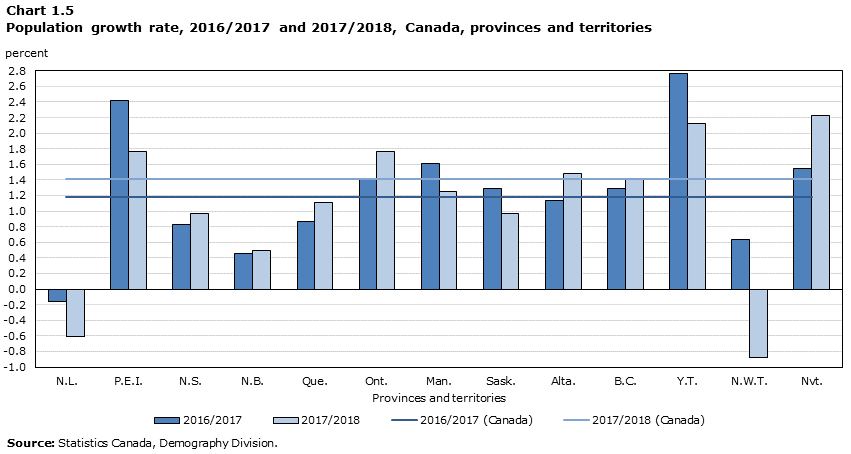
Data table for Chart 1.5
| Provinces and territories | 2016/2017 | 2017/2018 | 2016/2017 (Canada) | 2017/2018 (Canada) |
|---|---|---|---|---|
| percent | ||||
| N.L. | -0.2 | -0.6 | 1.2 | 1.4 |
| P.E.I. | 2.4 | 1.8 | 1.2 | 1.4 |
| N.S. | 0.8 | 1.0 | 1.2 | 1.4 |
| N.B. | 0.5 | 0.5 | 1.2 | 1.4 |
| Que. | 0.9 | 1.1 | 1.2 | 1.4 |
| Ont. | 1.4 | 1.8 | 1.2 | 1.4 |
| Man. | 1.6 | 1.2 | 1.2 | 1.4 |
| Sask. | 1.3 | 1.0 | 1.2 | 1.4 |
| Alta. | 1.1 | 1.5 | 1.2 | 1.4 |
| B.C. | 1.3 | 1.4 | 1.2 | 1.4 |
| Y.T. | 2.8 | 2.1 | 1.2 | 1.4 |
| N.W.T. | 0.6 | -0.9 | 1.2 | 1.4 |
| Nvt. | 1.5 | 2.2 | 1.2 | 1.4 |
| Source: Statistics Canada, Demography Division. | ||||
International migratory increase is the main driver of population growth in all provinces
Preliminary population estimates indicate that there were more deaths than births in all the Atlantic provinces, except Prince Edward Island. As a result, international migratory increase was the sole source of population growth in New Brunswick and the main contributor in Nova Scotia, since this province also saw gains in interprovincial migration. In Newfoundland and Labrador, international migratory increase (+0.2%) was not enough to offset the decline from natural decrease (‑0.2%) and interprovincial migration losses (-0.7%).
Ontario, Alberta and British Columbia were the only provinces where each of the three growth factors contributed positively to population growth. Moreover, international migratory increase was the main driver of population growth in Ontario and British Columbia. In Alberta, natural increase and international migratory increase contributed equally to the province’s population growth.
Quebec, Manitoba and Saskatchewan owed a large portion of their population growth to international migration, and to a lesser extent natural increase. However, these provinces recorded losses in interprovincial migration.
In the territories, natural increase was a greater source of population growth due to higher fertility levels. Natural increase in Nunavut (+1.9%)—the highest in Canada—was behind most of this territory’s population growth. In the Northwest Territories, strong natural increase (+0.9%) and positive international migratory increase (+0.3%) were offset by a considerable decrease in interprovincial migration (-2.0%). Yukon was the only territory to post higher international migratory increase (+1.1%) than natural increase (+0.5%).

Data table for Chart 1.6
| Natural increase | International migratory increase | Interprovincial migratory increase | Population growth | |
|---|---|---|---|---|
| rate (%) | ||||
| Canada | 0.3 | 1.1 | 0.0 | 1.4 |
| N.L. | -0.2 | 0.2 | -0.7 | -0.6 |
| P.E.I. | 0.2 | 1.9 | -0.3 | 1.8 |
| N.S. | -0.1 | 0.8 | 0.3 | 1.0 |
| N.B. | -0.1 | 0.6 | 0.0 | 0.5 |
| Que. | 0.2 | 1.0 | -0.1 | 1.1 |
| Ont. | 0.3 | 1.4 | 0.1 | 1.8 |
| Man. | 0.5 | 1.5 | -0.7 | 1.2 |
| Sask. | 0.5 | 1.2 | -0.8 | 1.0 |
| Alta. | 0.7 | 0.7 | 0.0 | 1.5 |
| B.C. | 0.1 | 1.1 | 0.2 | 1.4 |
| Y.T. | 0.5 | 1.1 | 0.5 | 2.1 |
| N.W.T. | 0.9 | 0.3 | -2.0 | -0.9 |
| Nvt. | 1.9 | 0.0 | 0.3 | 2.2 |
| Source: Statistics Canada, Demography Division. | ||||
A growing share of immigrants settle in Ontario
Ontario attracted 43.7% of new immigrants in 2017/2018, following a period of stagnation at around 37% in the three previous years to the benefit of the Prairie provinces. In the past year, 22.4% of immigrants settled in one of the three Prairie provinces, down from 27.2% in the previous period. However, this proportion was nearly three times higher than 20 years ago (8.4% in 1997/1998). The share of new immigrants settling in Quebec in 2017/2018 fell to 15.8%, compared with 19.5% in 2016/2017.
The estimated number of immigrants by province and territory is based on their intended province or territory of residence, as collected by the IRCC. This also applies to the calculation of international migratory increase and provincial and territorial population growth.
In the past year, the proportion of immigrants received by Ontario (43.7%) largely exceeded its demographic weight (38.6%). This was also the case for each western province, as well as Prince Edward Island, though the gap was narrower. The proportion of immigrants who settled in the Atlantic provinces (4.2%) remained practically unchanged from the previous period (4.1%). Nevertheless, it is twice as high as 20 years ago (2.0% in 1997/1998).
With the exception of Saskatchewan, Alberta and Newfoundland and Labrador, all provinces saw their number of non-permanent residents increase at an unprecedented rate in 2017/2018. Among others, Quebec showed a gain of 43,989 non-permanent residents, a peak all years combined. Ontario also recorded one of the highest increases in non-permanent residents (+85,695). It was the same in British Columbia, with a net gain of 25,474 non-permanent residents. Atlantic provinces (except Newfoundland and Labrador), Manitoba and Yukon have also recorded a peak number of non-permanent residents.

Data table for Chart 1.7
| Year ending June 30 | Atlantic provinces | Quebec | Ontario | Manitoba | Saskatchewan | Alberta | British Columbia | Territories |
|---|---|---|---|---|---|---|---|---|
| percent | ||||||||
| 1998 | 2.0 | 14.0 | 54.7 | 1.6 | 0.8 | 6.0 | 20.8 | 0.1 |
| 2003 | 1.2 | 17.5 | 55.1 | 2.5 | 0.8 | 6.8 | 16.0 | 0.1 |
| 2008 | 2.6 | 18.4 | 46.1 | 4.3 | 1.7 | 9.5 | 17.3 | 0.1 |
| 2013 | 2.2 | 21.3 | 40.2 | 4.8 | 3.7 | 14.0 | 13.6 | 0.1 |
| 2018 | 4.2 | 15.8 | 43.7 | 4.7 | 4.9 | 12.8 | 13.8 | 0.2 |
| Source: Statistics Canada, Demography Division. | ||||||||
Alberta posts interprovincial migration gains following two years of losses
At the provincial and territorial level, population growth is also the result of internal migration exchanges. Alberta saw interprovincial migration gains (+1,438) in 2017/2018, following two years of losses. Specifically, after posting the highest interprovincial migration gains for five consecutive years, from 2010/2011 to 2014/2015, Alberta saw the biggest losses in 2015/2016 (‑15,108) and 2016/2017 (-15,559).
The positive migratory growth in Alberta was due to more people staying in the province and to the province attracting more residents. Interprovincial migration gains in Alberta were the result of more in‑migrants (up 12,090 compared with 2016/2017) and fewer out‑migrants (down 4,907 compared with 2016/2017).
For a fifth straight year, Saskatchewan posted interprovincial migration losses. Moreover, interprovincial migration losses have continued in Manitoba since 1984/85. In contrast, Ontario (+17,886) and British Columbia (+7,799) had the strongest interprovincial migration gains in 2017/2018. Ontario’s interprovincial migratory increase in 2017/2018 reached its highest level since 2000/2001 (+18,623).
Elsewhere in Canada, Nova Scotia posted positive interprovincial migratory increase (+2,659) for a third straight year, while slight migration losses were once again recorded in New Brunswick (-49) following a pause last year. Manitoba (-9,199) and Saskatchewan (-9,083) saw the biggest interprovincial migration losses since 1989/1990 in the case of Manitoba, and since 2004/2005 for Saskatchewan.
Population growth and economic growth are often related. For example, internal migratory flows can be either a cause or a consequence of the economic situation, including variations in employment, unemployment or the price of certain raw materials. Therefore, the fact that more individuals moved to Alberta than left could be related to once-again favourable economic conditions in the province. Employment grew by 39,600 between July 2017 and July 2018, while the unemployment rate dropped 1.1 percentage points to 6.7% in July 2018.Note 11 Similarly, Alberta’s interprovincial migration losses in 2015/2016 and 2016/2017 could have been related to a decline in economic activity in the province at the time. In 2016, Alberta posted the highest unemployment rate ever seen in 20 years, as well as job and wage losses in most industries.Note 12 In contrast, interprovincial migration gains in Ontario occurred at the same time as the province posted the highest increase in employment in 2017 in the entire country, with a gain of 128,400 employed people, mostly full-time workers.Note 13

Data table for Chart 1.8
| Provinces and territories | In-migrants | Out-migrants | Net |
|---|---|---|---|
| number | |||
| N.L. | 5,672 | -9,328 | -3,656 |
| P.E.I. | 3,495 | -3,941 | -446 |
| N.S. | 16,613 | -13,954 | 2,659 |
| N.B. | 11,413 | -11,462 | -49 |
| Que. | 22,559 | -29,320 | -6,761 |
| Ont. | 79,927 | -62,041 | 17,886 |
| Man. | 10,060 | -19,259 | -9,199 |
| Sask. | 13,556 | -22,639 | -9,083 |
| Alta. | 62,486 | -61,048 | 1,438 |
| B.C. | 54,854 | -47,055 | 7,799 |
| Y.T. | 1,684 | -1,478 | 206 |
| N.W.T. | 1,651 | -2,562 | -911 |
| Nvt. | 1,256 | -1,139 | 117 |
| Source: Statistics Canada, Demography Division. | |||
The largest migration flows involve exchanges between Ontario, Alberta and British Columbia
The 30 largest migration flows are shown in the circular chartNote 14 below, in which each province or territory is assigned a colour. Migration origins and destinations are represented by the circle’s segments. Flows are the same colour as their origin, the width indicates their size and the arrow their direction.
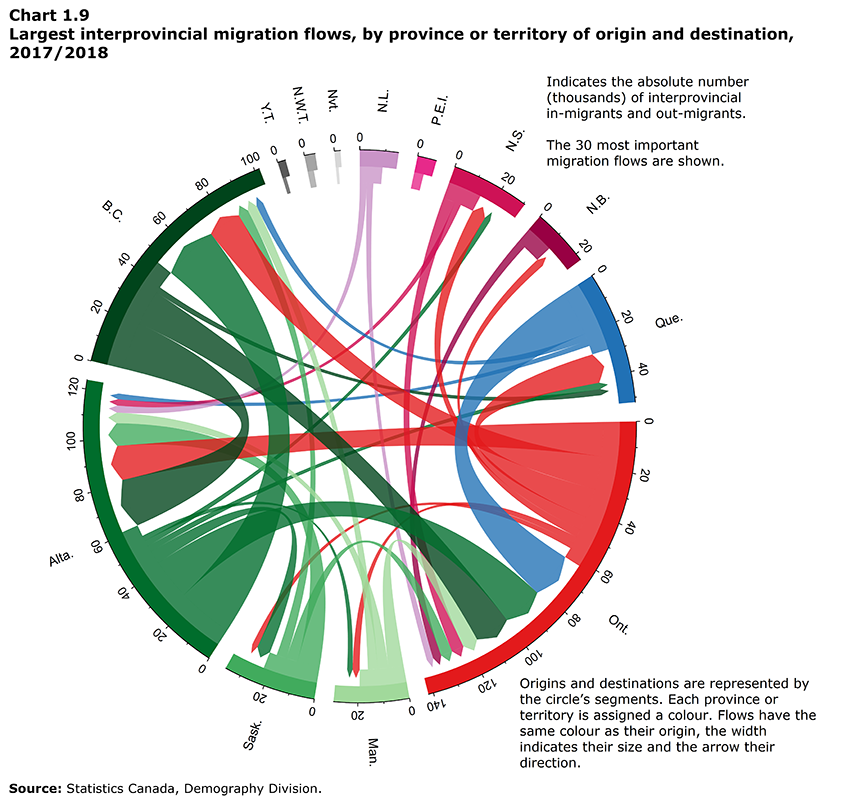
Description for Chart 1.9
Origins and destinations are represented by the circle’s segments. Each province or territory is assigned a colour. Flows have the same colour as their origin, the width indicates their size and the arrow their direction. Indicates the absolute number (thousands) of interprovincial in-migrants and out-migrants. The 30 most important flows are shown.
| Origin | Destination | ||||||||||||
|---|---|---|---|---|---|---|---|---|---|---|---|---|---|
| N.L. | P.E.I. | N.S. | N.B. | Que. | Ont. | Man. | Sask. | Alta. | B.C. | Y.T. | N.W.T. | Nvt. | |
| N.L. | Note ...: not applicable | 258 | 1,266 | 522 | 362 | 2,864 | 164 | 170 | 3,058 | 581 | 35 | 40 | 8 |
| P.E.I. | 183 | Note ...: not applicable | 556 | 374 | 160 | 1,674 | 35 | 41 | 459 | 426 | 12 | 9 | 12 |
| N.S. | 732 | 451 | Note ...: not applicable | 1,796 | 801 | 5,393 | 206 | 218 | 2,804 | 1,310 | 48 | 143 | 52 |
| N.B. | 324 | 486 | 2,254 | Note ...: not applicable | 1,635 | 3,689 | 217 | 235 | 1,832 | 714 | 8 | 27 | 41 |
| Que. | 228 | 199 | 807 | 1,578 | Note ...: not applicable | 19,814 | 358 | 434 | 2,483 | 3,125 | 79 | 74 | 141 |
| Ont. | 1,934 | 1,266 | 6,106 | 3,527 | 12,729 | Note ...: not applicable | 3,091 | 2,535 | 15,024 | 14,601 | 275 | 389 | 564 |
| Man. | 144 | 31 | 455 | 281 | 659 | 6,711 | Note ...: not applicable | 1,795 | 4,673 | 4,279 | 69 | 114 | 48 |
| Sask. | 144 | 93 | 413 | 199 | 469 | 5,065 | 1,629 | Note ...: not applicable | 9,927 | 4,471 | 134 | 88 | 7 |
| Alta. | 1,522 | 460 | 2,657 | 2,098 | 2,803 | 17,825 | 2,393 | 5,886 | Note ...: not applicable | 24,453 | 345 | 418 | 188 |
| B.C. | 337 | 219 | 1,765 | 896 | 2,686 | 15,542 | 1,841 | 1,992 | 20,904 | Note ...: not applicable | 549 | 220 | 104 |
| Y.T. | 14 | 0 | 56 | 38 | 54 | 387 | 0 | 86 | 286 | 451 | Note ...: not applicable | 54 | 52 |
| N.W.T. | 45 | 23 | 150 | 43 | 127 | 537 | 83 | 124 | 942 | 344 | 105 | Note ...: not applicable | 39 |
| Nvt. | 65 | 9 | 128 | 61 | 74 | 426 | 43 | 40 | 94 | 99 | 25 | 75 | Note ...: not applicable |
| ... not applicable Source: Statistics Canada, Demography Division. |
|||||||||||||
Over the past year, the largest interprovincial migration flow was from Alberta to British Columbia (24,453 migrants). The flow in the other direction, i.e., from British Columbia to Alberta, involved 20,904 migrants and was the second largest interprovincial migration flow. When taken into account, these exchanges between the two provinces result in a gain of 3,549 for British Columbia. These net gains in British Columbia, at the expense of Alberta, were also three times lower than last year (+10,774). This in part explains net gains in British Columbia two and a half times lower (+7,799) than in 2016/2017 (+18,834), all provinces of origin combined.
Since fewer Albertans left the province for British Columbia in 2017/2018, and more people left Saskatchewan, Manitoba and Newfoundland and Labrador for Alberta in 2017/2018 (+7,857) compared with 2016/2017 (+2,542), a net interprovincial gain was recorded in Alberta.
The third largest interprovincial migration flow in Canada came from Quebec to Ontario (19,814). The size of this flow is primarily due to their proximity and the demographic weight of these provinces—as the two most populous.
In relative terms expressed as rates,Note 15 the largest interprovincial migration flows among provinces were from Prince Edward Island to Ontario (+1.1%), from Saskatchewan to Alberta (+0.9%), from Newfoundland and Labrador to Alberta, from Alberta to British Columbia and from Nova Scotia to Ontario (+0.6% each).
Rebasing (2016)
The estimates released in this publication are now based on the 2016 Census adjusted for census net undercoverage and partially enumerated Indian reserves. Population estimates between July 1, 2011 and April 1, 2016 have become intercensal. In consequences, the 2016 error of closure was estimated at 110,310, for an error of closure of 0.31%. This error is relatively higher than the level recorded in 2006 (0.10%) and relatively lower than the 2011 error of closure (0.42%)Note 16.
The error of closure is a measure of accuracy of the postcensal estimates. It is defined as the difference between the final postcensal estimate on Census day and the census population adjusted for coverage. The error of closure comes from three sources: errors primarily due to sampling when measuring the starting and end of period censuses coverage and errors related to the components of population growth over the intercensal period.
Intercensal growth
On July 1, 2016, the estimated population of Canada based on the 2016 Census was 36,109,487. At the national level, intercensal population growth between the 2011 and 2016 censuses was 5.0%, or 1.8 million people. This growth was similar compared to the level observed in the previous intercensal period 2006 to 2011 with 5.3%. Between 2011 and 2016, net international migration accounted for two-thirds of Canada’s population growth.
Between 2011 and 2016, Canada’s population growth rate (+5.0%) was the highest among the G7Note 17 countries, including the United States (+3.7%), the United Kingdom (+3.7%), France (+2.7%), Germany (+2.6%), Italy (+2.2%) and Japan (-0.7%). Among industrialized countries, Canada’s current population growth fell below the estimated rates for countries such as Australia (+7.7%) and New Zealand (+6.9%)Note 18.
In general, population growth in the provinces and territories between 2011 and 2016 was lower than or equal to the level observed in the period between 2006 and 2011, except in Manitoba, British Columbia and the Northwest Territories. In addition, the population in every province and territory increased between 2011 and 2016, with the exception of Nova Scotia. In comparison, all provinces and territories saw an increase in their population between 2006 and 2011.
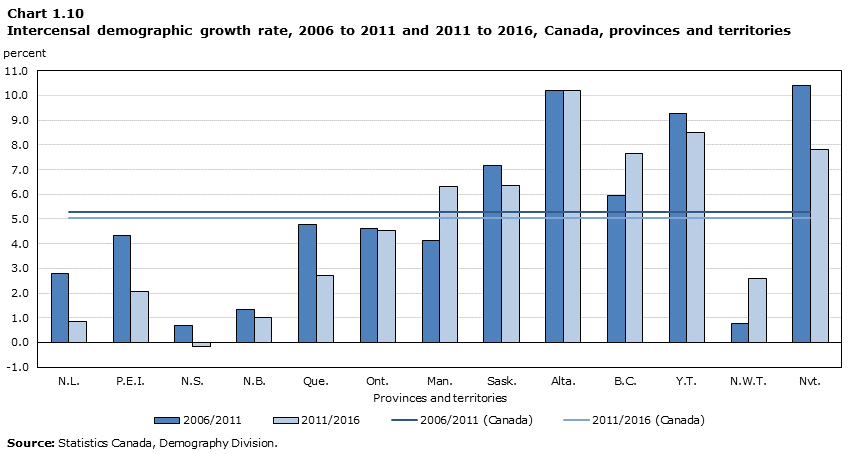
Description for Chart 1.10
| Provinces and territories | 2006/2011 | 2011/2016 | 2006/2011 (Canada) | 2011/2016 (Canada) |
|---|---|---|---|---|
| percent | ||||
| N.L. | 2.8 | 0.8 | 5.3 | 5.0 |
| P.E.I. | 4.3 | 2.1 | 5.3 | 5.0 |
| N.S. | 0.7 | -0.2 | 5.3 | 5.0 |
| N.B. | 1.3 | 1.0 | 5.3 | 5.0 |
| Que. | 4.8 | 2.7 | 5.3 | 5.0 |
| Ont. | 4.6 | 4.5 | 5.3 | 5.0 |
| Man. | 4.1 | 6.3 | 5.3 | 5.0 |
| Sask. | 7.2 | 6.4 | 5.3 | 5.0 |
| Alta. | 10.2 | 10.2 | 5.3 | 5.0 |
| B.C. | 6.0 | 7.6 | 5.3 | 5.0 |
| Y.T. | 9.3 | 8.5 | 5.3 | 5.0 |
| N.W.T. | 0.7 | 2.6 | 5.3 | 5.0 |
| Nvt. | 10.4 | 7.8 | 5.3 | 5.0 |
| Source: Statistics Canada, Demography Division. | ||||
For the 2011 to 2016 intercensal period, population growth was low in the Atlantic provinces, but high in the Western provinces and most of the territories. Compared with the national rate (+5.0%), growth was stronger in Alberta (+10.2%), Yukon (+8.5%), Nunavut (+7.8%), British Columbia (+7.6%), Saskatchewan (+6.4%) and Manitoba (+6.3%). By contrast, the population grew less rapidly in other provinces and territories.
Notes
- Date modified:
